Tesla Last Word
Whoopsie. Left One Out.
Not mentioned "yesterday" since it wasn't yet in the news: another autopilot crash. This time a Tesla SUV crashed into a highway divider, killing the driver (or "driver") whose hands were off the wheel five seconds before the crash occurred. That's most of what's known as of the end of March, which has somehow turned into Tesla Month here on the RIKLBlog.
This information came out yesterday, not "yesterday." The stock market was closed for a religious holiday and financial repercussions on Tesla can't be predicted immediately, at least not by me.
This Non-Prophet Blog is Again About the Powerwall
I've been living with my three-Powerwall ensemble for the past few weeks, and as is often the case when I get a new science toy, I get a little obsessive about it. I analyzed its benefits as a time-of-use shifter to save on electricity and did a "best case" analysis* of how monetarily valuable it was. I originally came up with a figure of about $1000/year.
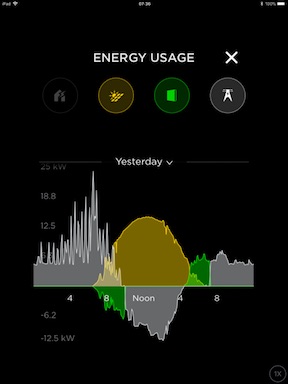 |
Still guesswork, but with a bit of data gathering behind it, I now have at least a reasonable figure for March. Note the two green areas on the Energy Usage display to the left. The display itself shows (in grey) the energy taken from and returned to the grid. Yellow is the rising and setting sun on what was a very nice day. The left green area shows my solar system re-charging the Powerwall from its previous-day discharge. The right green area shows the Powerwall discharging while supplying increasing amounts of electricity as the sun goes down. Without TOU yet available on my version of the Tesla app, I have been manually "customizing" the charge percentage to restrict Powerwall discharge to my peak hours—noon to 19:00. |
The Tesla app provides daily statistics on energy flows, including "from Powerwall" and "to Powerwall." Eyeballing my spreadsheet for the past few weeks, it looks like the Powerwalls are supplying about 15kWh per day. Since the only time they discharge is during peak hours, this corresponds to a saving of $.21*15 per day, or about $750/year, somewhat less than I previously calculated. Note that this is a very rough average for March only. Perhaps counter-intuitively, it will save more money in winter days of less sunlight. The Powerwall is quiescent for much of the day even in the spring. During the winter hours of reduced sunlight, it will probably charge for an hour or two less, but discharge for an hour or two more, providing more TOU shifting. Although I've been adjusting the charge/discharge period manually, I've read that some Tesla Forum members have already received the updated app that will automate the process. Hopefully today is the end of what has turned out to be Tesla Month. I'll try to remember to update this info at least seasonally. |
|
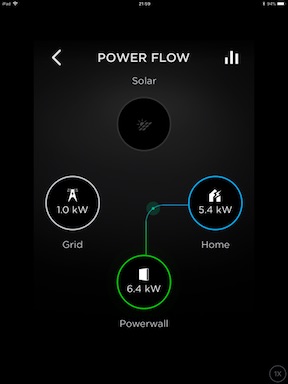 |
While looking at the app display this month, I've noticed a few outlier screens, and just thought I'd document them here. Maybe they represent bugs or oversights, although they seem pretty benign. This display shows a destination-free kW being drawn from the grid. Perhaps it's disappearing into another dimension. |
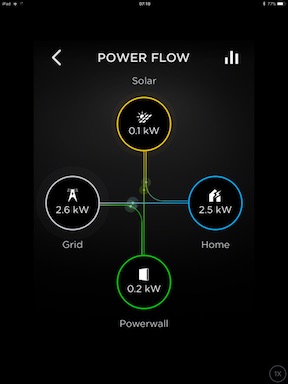 |
This display shows 100 Watts being delivered from the grid to the Powerwall. Although it probably is just a least-significant-digit error in the current monitors, it encouragingly implies that it is possible to charge the Powerwall from the grid. This isn't supposed to be possible with the present app, but clearly can be accomplished with the hardware. |
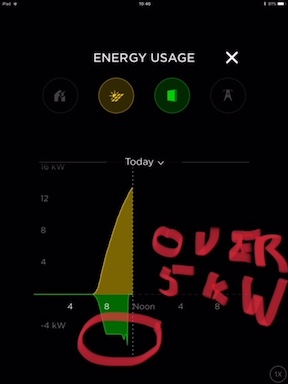 |
A number of Tesla forum members have noted that the Powerwall seems incapable of charging faster than a given maximum rate depending on how many of them are in the ensemble. My 3-Powerwall system normally refuses to accept more than a 5kW charge no matter how much surplus power is available from the solar system. However, I have noted that when the Powerwall is within a few per cent of full charge, the allowable charge rate goes up. Some have speculated that the charge rate limitation has to do with the battery's cooling system, which seems to make sense. If the battery is almost charged, and the temperature is low enough, perhaps it calculates that even at a higher charge rate the temperature won't rise high enough to cause a problem before the battery is fully charged and the current is cut off. |
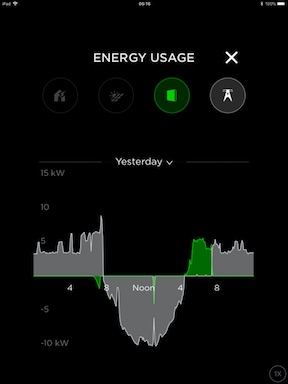 |
A rare emendation of a blogitem after publication. Call it the 33rd of March, 2018. I noticed an oddity in the middle of the day. The Powerwall was fully charged since early morning, but suddenly a significant amount of power from the solar system was briefly diverted from the grid to the Powerwall. There doesn't seem to be any reason for it. Hopefully it isn't a glitch in the software or a defect in the hardware. Hmmm.
|
Tesla isn't forthcoming with technical data, hence all the speculation, both here and on their forums. But I promised not to complain 'til I get the new app, allegedly no later than 20 April.
There's been so much Tesla babble this month on my blog that I haven't even had time to whine about my cellphone crisis, the lack of standard (never mind double- or mega-Stuf) Oreos on Southwest Airlines, or any of the activities that have consumed yet another of the diminishing number of months remaining before the System accosts me. One comfort: According to a rumor I just read, "hell" may now be out.
* Previously I used the word "guess" instead of "analysis" and was hoping you'd have forgotten by now.


